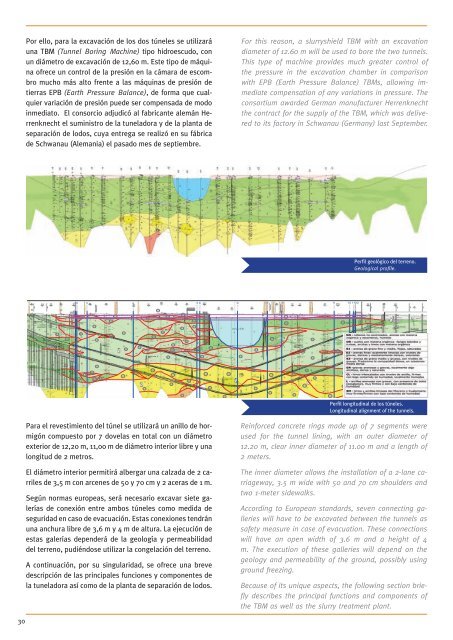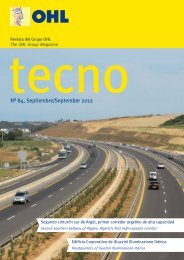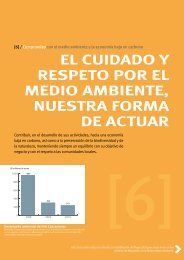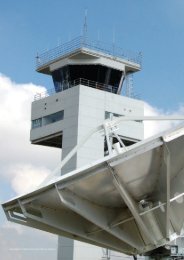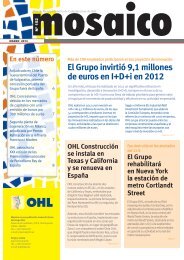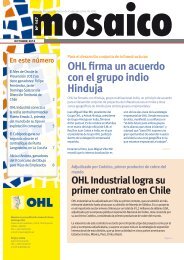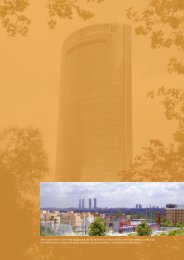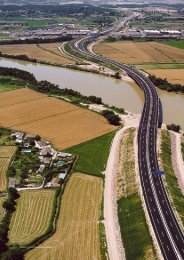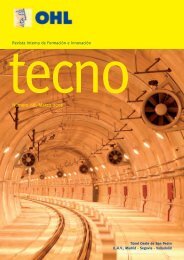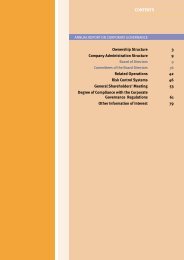Revista Tecno - ACM2 . Avalora Content Manager - Ohl
Revista Tecno - ACM2 . Avalora Content Manager - Ohl
Revista Tecno - ACM2 . Avalora Content Manager - Ohl
Create successful ePaper yourself
Turn your PDF publications into a flip-book with our unique Google optimized e-Paper software.
30<br />
Por ello, para la excavación de los dos túneles se utilizará<br />
una TBM (Tunnel Boring Machine) tipo hidroescudo, con<br />
un diámetro de excavación de 12,60 m. Este tipo de máquina<br />
ofrece un control de la presión en la cámara de escombro<br />
mucho más alto frente a las máquinas de presión de<br />
tierras EPB (Earth Pressure Balance), de forma que cualquier<br />
variación de presión puede ser compensada de modo<br />
inmediato. El consorcio adjudicó al fabricante alemán Herrenknecht<br />
el suministro de la tuneladora y de la planta de<br />
separación de lodos, cuya entrega se realizó en su fábrica<br />
de Schwanau (Alemania) el pasado mes de septiembre.<br />
Para el revestimiento del túnel se utilizará un anillo de hormigón<br />
compuesto por 7 dovelas en total con un diámetro<br />
exterior de 12,20 m, 11,00 m de diámetro interior libre y una<br />
longitud de 2 metros.<br />
El diámetro interior permitirá albergar una calzada de 2 carriles<br />
de 3,5 m con arcenes de 50 y 70 cm y 2 aceras de 1 m.<br />
Según normas europeas, será necesario excavar siete galerías<br />
de conexión entre ambos túneles como medida de<br />
seguridad en caso de evacuación. Estas conexiones tendrán<br />
una anchura libre de 3,6 m y 4 m de altura. La ejecución de<br />
estas galerías dependerá de la geología y permeabilidad<br />
del terreno, pudiéndose utilizar la congelación del terreno.<br />
A continuación, por su singularidad, se ofrece una breve<br />
descripción de las principales funciones y componentes de<br />
la tuneladora así como de la planta de separación de lodos.<br />
For this reason, a slurryshield TBM with an excavation<br />
diameter of 12.60 m will be used to bore the two tunnels.<br />
This type of machine provides much greater control of<br />
the pressure in the excavation chamber in comparison<br />
with EPB (Earth Pressure Balance) TBMs, allowing immediate<br />
compensation of any variations in pressure. The<br />
consortium awarded German manufacturer Herrenknecht<br />
the contract for the supply of the TBM, which was delivered<br />
to its factory in Schwanau (Germany) last September.<br />
Perfil geológico del terreno.<br />
Geological profile.<br />
Perfil longitudinal de los túneles.<br />
Longitudinal alignment of the tunnels.<br />
Reinforced concrete rings made up of 7 segments were<br />
used for the tunnel lining, with an outer diameter of<br />
12.20 m, clear inner diameter of 11.00 m and a length of<br />
2 meters.<br />
The inner diameter allows the installation of a 2-lane carriageway,<br />
3.5 m wide with 50 and 70 cm shoulders and<br />
two 1-meter sidewalks.<br />
According to European standards, seven connecting galleries<br />
will have to be excavated between the tunnels as<br />
safety measure in case of evacuation. These connections<br />
will have an open width of 3.6 m and a height of 4<br />
m. The execution of these galleries will depend on the<br />
geology and permeability of the ground, possibly using<br />
ground freezing.<br />
Because of its unique aspects, the following section briefly<br />
describes the principal functions and components of<br />
the TBM as well as the slurry treatment plant.


